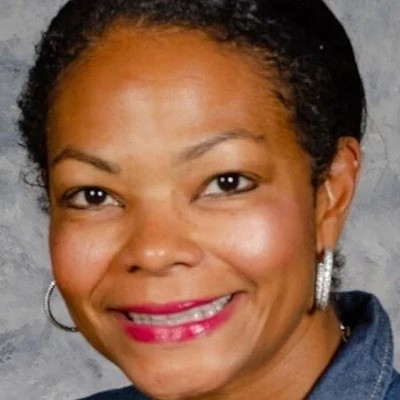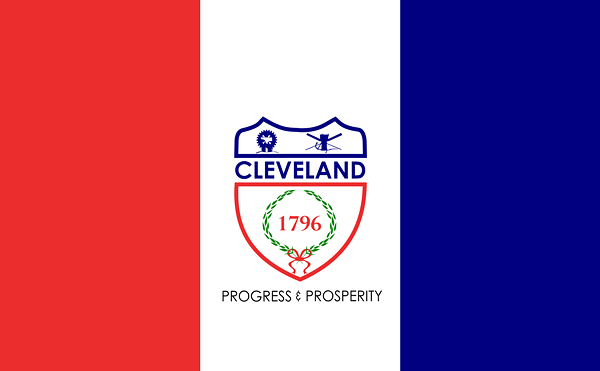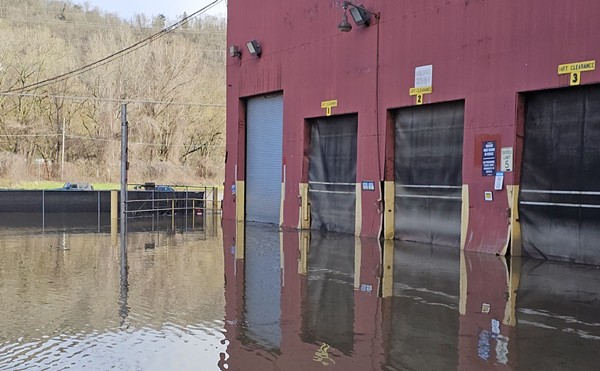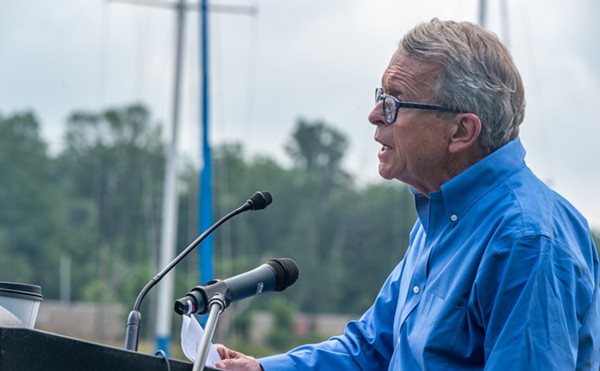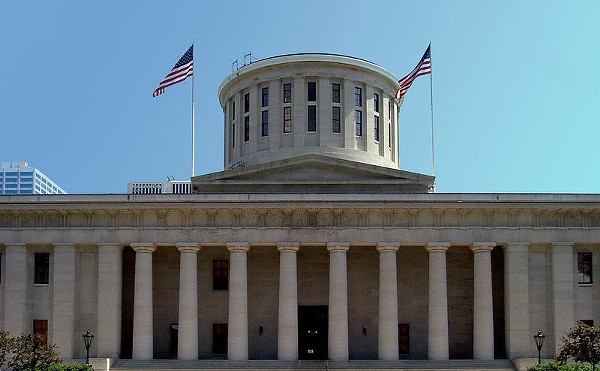But then Victor, her husband, a dependable sort who'd lived on his own since he was 12, sweetened the deal.
"He said I'd have a machine to wash the clothes," recalls Lucy, a short, round woman with swollen ankles and gray hair swirled in a bun. She wasn't even sure how a washing machine worked -- she just knew she wanted one.
So in 1959, Lucy, Victor, and their children gathered their belongings and boarded a train for Cleveland. They planned to return in a year, enriched, to New Mexico, where Lucy's relatives lived on the Taos Pueblo Indian Reservation.
Victor was hoping to get an education. Crippled from a factory job lifting 50-pound bags of sugar, he wanted to go to barber school and make a decent wage. It was part of a new relocation policy for Indians. They'd agree to live in one of seven cities, Cleveland being one, in exchange for a good job and a nice place to live.
Eager for brighter prospects, Victor filled out an application at the local Bureau of Indian Affairs office. The response was swift: Move your family to Cleveland, and you can start school right away.
They arrived in a blizzard. "It was freezing," remembers Lucy. "I was kind of afraid we weren't gonna make it, because it was too cold. We had real thin clothes."
The BIA found them an apartment on a flea-bitten section of Euclid Avenue. "It was kind of scary for me," she says of the neighborhood. "I was afraid to even go outside.
"But the landlord was so good. I [asked] him if there's a washing machine around here. He said, 'It's in the basement.' I said, 'What's a basement?' We don't have no basement back home."
There were many things to learn: Don't be afraid of black people (she'd never seen a black person before). Push your way onto the bus; if you're too polite, you'll get left standing in the snow. Even when she mastered these, the native Taos speaker still struggled with the language barrier. A fierce loneliness set in, never really subsiding.
"I was real close with my mother," she explains. "My husband told my mother, we're just gonna stay for a year, and then I'll bring her back. But we never did go home."
Though they might seem like immigrants pursuing the American dream, Lucy and Victor were Americans who left their ancestral home after realizing that, in the land of opportunity, their options were slim to none.
Worlds away from the rural reservations, versed in "Indian" tradition only when it meant Chief Wahoo, Cleveland was one of the cities the Eisenhower Administration designated for American Indian relocation. It was part of a grand plan to clear off the reservations that would free up government money and leave the land, rich in natural resources, wide open to industry. And it was put in motion by Dillon S. Myer, a hatchet man appointed by Truman.
Myer had already dirtied his hands on Japanese Americans during World War II, orchestrating their relocation to prison camps in California. Though they weren't penned in by barbed wire, the relocated Indians were imprisoned by lack of choices.
"They were hoping our children would marry non-Indians and disappear from America," declares activist and actor Russell Means, the most famous Cleveland relocatee and a man hard-pressed to mince words. "That was their stated aim. In hindsight, it was a purely genocidal program."
With a negligible native population and a homely reputation, Cleveland was the least popular relocation city (the other destinations were Denver, Dallas, Los Angeles, Chicago, New York, and San Francisco). Still, about 10,000 Indians from more than 60 tribes relocated here. Some came to Cleveland because they had big families that didn't fit in other cities' crackerboxes or because somebody's brother-in-law's cousin told them it was the best for education. Some came because Cleveland was the only city without a waiting list.
Once they stepped off the bus, they were often shipped to slums by number-crunchers who'd promised more than they could deliver.
"What they were doing was creating the American Indian diaspora," Means says. "They put us into the ghettos of the city, and they spread us out."
Not all stuck it out. Many returned to the reservation when their proverbial pot of gold turned out to be filled with chump change. Others gave up because they were homesick or they were laid off from their jobs. The ones who stayed were treated with ignorance and ambivalence.
Only about 3,000 Indians remain in Cleveland. Maybe because their numbers are small, their story is obscure. Without their own ethnic radio show or an ornate hall for functions, their profile here is pretty low. But their reasons for coming here shouldn't be forgotten, lest history repeat itself.
"Here's a story people are not paying any attention to," observes Esther Bockhoff, a Cleveland cultural anthropologist who's befriended some of the relocatees. "We're not studying anything about their history. Yet there are three or four thousand in Cleveland. Where do these people come from?"
Some came from Oklahoma, formerly called Indian Territory, where the Five Civilized Tribes walked the infamous Trail of Tears in the mid-1800s. Others came from barren South Dakota plains darkened by the stone shadow of Teddy Roosevelt, president and Indian killer. Still others hailed from the pink-veined valleys of the Southwest, where white settlers considered them expendable. They say that economically, they have a better life in the city, but they still ache for their families and the old ways.
Generally, city-dwelling Indians have a standard of living three times greater than reservation Indians. But the price paid was high: Some tribes disappeared altogether. Urban Indians found themselves alienated from their culture, and as they intermarried, their grandchildren and great-grandchildren were often left off tribal rolls altogether.
"Our tribes have histories of long walks and relocations," remarks Bernice Begay, a Navajo who relocated here from Pinedale, New Mexico, in 1974. "There's nothing the government could do that would ever correct it. So they tried to forget the native people here."
"A horrible experience" is how Means remembers his brush with Cleveland's underbelly. Composed, well-spoken, and trained as an accountant, he nonetheless had a hellish time coming here with his wife, Betty, and their two children.
"First of all, the BIA gave us $88 for a family of four to drive from South Dakota to Cleveland and then did not tell us about the tollways," he says, recalling his first taste of turnpike. "Luckily, we had extra money, or we would've never made it. I guess they expected us to sleep in the car."
The frazzled family was assigned substandard digs on Euclid Avenue. Rarely at a loss for vivid description, Means remembers the place as "a sleazy motel where a society of degenerates lived. There were prostitutes, drug dealers, people making love in the hallways."
The next morning, he beat a path to the BIA office, demanding to see the boss. It took several weeks and much griping -- even a few well-placed threats -- but his family was finally given a spacious apartment in a spotless suburban neighborhood.
More soft-spoken souls often got dumped on, though.
"I found out later that the night we were there, a Choctaw family had already been living in that same hotel for a year and a half," says Means. "Three years later, they were still living there. The wife couldn't speak English, and the husband spoke broken English. They had laborer jobs. [The BIA] had no business relocating these people without some rudimentary teaching of English, some rudimentary training of urban life."
In those days, the BIA was a "horror story," he says. "If you complained, they'd threaten you with returning you home. They thought that reservation life was so ugly, 'they'll immediately obey everything we have to say.'"
While Means spent several years here, Seth H. Big Crow Sr., a tribal aide with a built-in BS detector, lasted only three months. In 1964 the relocation office on South Dakota's blighted Rosebud reservation painted Cleveland as a golden utopia where school was free and good jobs were ripe for the picking. It sounded like a plum deal, especially since unemployment on the reservation topped 85 percent.
What he got was a one-way bus ticket that took him "from the prairies and trees and a whole lot of life into a busy, busy town with nothing but concrete." The BIA found him a job as an unskilled construction laborer, but he had to take five buses to get there.
The promised schooling never surfaced. Dispirited by the long commute to work, Big Crow found a closer job making venetian blinds that was "boring as all get-out." He celebrated his first paycheck by packing up his family and buying return fare to South Dakota.
"Maybe it's a little bit hard out here, but at least we don't have to go through that," reflects Big Crow, who now works for the BIA on the reservation. "Here, I could get jobs on the same level that I did out there."
Coming from a respected reservation family that included chiefs and medicine men, Faye Brings Them's father was a trained welder when he signed up for relocation.
Though they were one of the more prosperous clans on the reservation, Brings Them's family, the Yellow Eagles, still lived off the land, tilling the coarse earth in spring and counting on seasonal work in winter.
To make the food stretch further, all seven children were sent to boarding school, where they couldn't speak their language and were taught square dances instead of sun dances. Modeled after military academies, the government-run boarding schools, often hundreds of miles away from home, were many Indians' only means of public education. (The day schools at the reservation were either pitiful or charged tuition.) Since the 1830s, boarding schools had been a systematic way of assimilating Indians into white society, severing family ties and sometimes literally beating the life from children. For a generation already weaned from Indian ways, relocation was meant to complete the circle.
In Cleveland, the Yellow Eagles were placed in the projects on Central and Cedar. Things didn't go smoothly: Brings Them's new classmates freaked her out by touching her hair and skin, and asking if she was a "real" Indian. Her brother got lost on the first day of school, walking out the wrong door and wandering for hours, searching for home.
"When people asked him where he lived, he'd say, 'I live in the houses all stuck together,'" Brings Them recollects.
Skilled and ambitious, Brings Them's father scored a job as a laborer at Westinghouse, where a lot of Indians worked, and rose through the ranks to foreman. But last hired, first fired -- so when layoffs came, he was jobless again, and her family moved back to the reservation.
Determined to work and attend college, Brings Them stayed behind. She met her husband, Richard, a Standing Rock Lakota, here. But they returned to the reservation, where Faye was hired as a social worker, placing Indian children with adoptive Indian families.
In 1985 she was laid off. It was hopeless finding another job on the reservation, so they moved back to Cleveland.
Having learned the value of versatility, Brings Them now works construction and sells her handmade beadwork. True to her elders, who were famous on the reservation for their hospitality, she's adopted two Indian daughters and opens her home to neglected neighborhood kids.
"Rosebud still has an 85-plus unemployment rate," notes Brings Them, a friendly, middle-aged grandmother with feathered hair and glowing skin. "It could be close to 90 percent. It was very good [in Cleveland]. Things opened up to us here.
"The way they treat the blacks in the South, that's the way they treat the natives out west. When my son was in [reservation] grade school, his teacher said that 'Indians don't become doctors, Indians don't become attorneys.' I thought, 'What a thing for her to be teaching!'"
Today, the BIA considers relocation a mistake. A "total repudiation" of the policy began in 1968 with the Indian Self-Determination Act, which gave tribes more power to take over government programs, and it officially ended in 1980.
"People in the bureau weren't sensitive to the culture," observes Ross Swimmer, former chief of the Cherokee Nation and head of the BIA under President Reagan. "They didn't understand what these relocatees were going through, and they didn't take the time to help them get acclimated. It was an enormous shock, moving from a rural community -- particularly a tribal reservation -- to a large city. There should have been a lot of hand-holding."
There wasn't any hand-holding between Jim Lemieux's parents when they relocated from Minnesota. That's because his mom, a product of Catholic boarding school, had already taken the kids and separated from his dad, an unemployed veteran partial to blowing the family budget at the bar. In Minnesota, during a drunken rage, he'd once left his family to freeze to death in the forest.
The relocation office offered Lemieux's father a job, with one stipulation: He had to bring his estranged family.
"From what I understand, they came to my dad and told him that they would send him to Cleveland, send him to school for welding, but if he didn't go, there was no welfare or anything for the family," muses Lemieux, a contemplative father of three who works as a computer draftsman in Solon.
"At the time, my mom was not on any type of assistance, and there was no work. She probably felt bad because my dad had a chance to get the schooling, so she decided that she would come along so he would get ahead."
In Cleveland, the Lemieuxs were placed in the projects on Scovill Avenue, where they were the only Indian family. Thirteen people crammed into three bedrooms was an improvement from life on the reservation, where there were many "hungry times," Jim says.
"It was hard," he says of life in the projects, a far cry from the woodlands he knew. "It was a lot more people and a lot less room. But we were all kids, so we kind of adjusted to it. We could get something to eat."
Again, alcoholism broke things up. Lemieux estimates he went to about 10 different schools during that part of his childhood.
"I knew it was hard on the family," he says. "Eventually, my mom was the one taking care of us. It was really hard on her. He would drink up all the money."
Pausing to reflect on those years, Lemieux calls relocation "an attempt at genocide under the auspices of being good.
"What's a job for a hunting and gathering society?" he asks. "On my birth certificate, my father's occupation was 'woodsman.' I remember going with him to check traps."
Perhaps things would have been different if his dad hadn't served in World War II. When he drank, that's what he talked about. In the war, he was a celebrated scout valued for his tracking skills, sent behind enemy lines at night to cut throats and wire outhouses with explosives. But at home, he was just another drunk Indian.
For many Indians, even third-rate treatment was a step up. Sally Gayton, for instance, couldn't get far enough away from Ponca City, Oklahoma, where wages for Indians were dismal.
Cleveland was sounding pretty good to the hard-working, matter-of-fact mother of 11.
"My idea was to get as far away from my family as I possibly could, so I wouldn't go running to them for help," says Gayton, who's been employed as a seamstress, a Cleveland BIA clerk, and an energy coordinator for a neighborhood housing association. She was placed on a waiting list for Denver, her first choice, but her name never came up.
"After two years being at home, with no employment and no place to live, I was ready to go anyplace," she recalls. "We took Cleveland, except when our time came up, I was pregnant, so they put me off again. I had to wait until the baby was born."
Finally, she "headed for Cleveland with a $90 check and a station wagon full of kids." She'd only been out of the state once before.
Though her relatives felt as if she were deserting them, what she was really running away from were poverty and prejudice.
"We didn't have many jobs, and because you were Indian, you weren't gonna get hired anyway," she says. "Back there, the only thing they make is minimum wage. Most of them are working in the bingo halls. A very few work in the hospital, a McDonald's, nursing homes." She didn't want to end up like her sisters, high-school graduates shackled to jobs as hotel maids.
Neither did Mary Jane Buckshot, who'd spent some of her so-called best years in boarding school, dropping out before she could graduate.
"A lot of times, it makes me mad, how those Indian schools were," remarks Buckshot, a spry grandmother with curly hair and pointy glasses. "We were never told we could be anything we wanted to be. There was no such thing as being a nurse or a white-collar worker. We learned to cook and clean and all of that. To be a housewife."
In Cleveland, living on an $89 monthly subsidy check, Buckshot took courses at a professional secretaries' school. Before she could graduate, the school went bankrupt and closed. Her life got happier the day she walked past a construction site and caught the eye of her future husband, a French Canadian Indian ironworker, now deceased, whom she speaks of tenderly. They settled here and bought a house.
"I grew to love Cleveland," she says. "It's home now. Over the years, I met so many people. I got an education.
"But it was so different. I missed my family. I missed a lot of the traditional ways of life and of doing things, the teachings and value systems. I feel for my children. They've grown up without all of those values. And I miss speaking my language."
It was best to go and not look back, thought Bernice Begay as she left her home "in back of the hills," where the Navajos respect the four sacred directions.
If you were sentimental, you'd get cold feet and never leave the reservation.
"I needed to do something with my life," she reflects, her silver earrings catching the light. "[Relocation] was the only way I could go.
"There is absolutely nothing to do on the reservation. It hasn't changed. Eighty percent of our people are still alcoholics. The younger generation start drinking because there's nothing to do. If I was still there, I probably would've been an alcoholic. I don't know what I would've done."
A year after she graduated from boarding school, Begay applied for relocation.
"Everybody wanted to go to Denver and California," she recalls. "Most of the people from the Southwest went there. But when they said Cleveland, I said, 'Fine, if that's the fastest.' Three days later, they put me on the bus."
One of the later relocatees, Begay had help when she arrived. By 1974, Means and several others had founded Cleveland's American Indian Center, which provided social services and made sure the BIA office didn't cut its clientele short.
No longer isolated in the city's various ghettos, the Indians had organized. They protested the hiring of non-Indians at the local BIA office and got Indians hired. They picketed union halls when unions refused to hire Indians. And they threw Moses Cleaveland into the Cuyahoga River. Or at least the unsuspecting actor playing him at the city's sesquicentennial gala.
Someone from the Early Settlers Association, which was reenacting Cleaveland's "discovery" of the Western Reserve, had rung up the Indian Center with a special request.
"They wanted us to come down and dance for them," says Means. "We said, 'Okay, we'll be down.'" Expecting a warm reception, Moses instead got a dunking that day.
By then, the BIA office was a fairly smooth-running machine. Begay received a tidy temporary apartment at the YWCA and an education as a legal secretary. Now living in Middleburg Heights, she's worked at the same place for 25 years -- she's a case administrator at American Arbitration, a nonprofit company that settles labor disputes.
Thankful for the opportunity, she still wishes she'd had another choice. With relocation, she asserts, "You were told you were gonna go to school, get an education. They'd pay for this, pay for that, whatever you need. They took us away. They enticed us. It was like giving a kid a candy bar."
Though the government failed to obliterate the Indian race, to some extent its plan worked, the result being that half of all Indians now live off the reservation.
Jason Tetzloff, assistant professor of Native American studies at Ohio's Defiance College, calls relocation "forced assimilation."
"To say that it was voluntary is incorrect," remarks Tetzloff, who's written extensively on the subject. "Many did move voluntarily, but during the '50s and such, the official policy was 'Get the Indians off the rolls and away from the reservation.'
"You have to remember, too -- these people were coming into this new situation with fewer educational opportunities and fewer economic resources. So they hit this triple whammy. Native American education on the reservation was abysmal, vocational at best. All of a sudden, you're going from dirt roads to four-lane highways, from a family-based culture to one where you're anonymous."
Rather than yanking people from their homelands, says former Cherokee Nation Chief Swimmer, the government could have easily brought jobs to the reservations.
"Our country has gone into third-world countries like Puerto Rico, down on the island, where there's people living in abject poverty," he elaborates. "They have developed those economies, through tax policies and subsidies for industries. The same could be done for the reservations overnight, if our government could figure that out. It would give Indian people on reservations a choice that they don't have now."
Despite its shortcomings as Indian central, Cleveland was a great place for the relocatees to test ways of collectively looking out for themselves.
Where the BIA failed, the American Indian Center took over. Started by Means, Brings Them's mother (Irma Yellow Eagle), and a few others, it provided food, shelter, legal aid, education, and camaraderie for Indian families.
Center workers furnished bus fare back to the reservation for so many destitute relocatees, they nicknamed themselves the "reverse relocation program."
Means calls that program "one of the most gratifying parts of my life.
"In the 1980s, when I was living down on the Navajo reservations, different families would come up to me and thank me for helping them go home," he says. "Then they'd point to their children, introduce me to them, and tell me how very successful their kids are."
Brings Them, who leads Chief Wahoo protests as head of the Lake Erie Native American Council, has many dear memories of those days. Like the time Means made a special trip to her high school, defending her right to sit out a black history class.
"I asked my mom to ask Russell to come to the school," she says. "He told the principal, 'If they can't offer a Native American history class, she shouldn't have to take black history.' I didn't have to take it."
Or the time Means led the American Indian Movement in the takeover of the BIA headquarters in Washington for the "Trail of Broken Treaties" protest.
Brings Them and a friend were supposed to stay in Cleveland and run things in the elders' absence. But thanks to a last-minute phone call from a generous donor, they ended up on a plane to Washington.
"We flew in that night," she recalls. "They had blockaded all the doors. Russ is standing there, shaking his head: 'I left you two in charge of the Indian Center!'"
Guarding the building round-the-clock from the National Guard left her so worn out, she crashed on the third day, during an auditorium powwow.
"I laid my head down on the stage area," she remembers, laughing. "There were drums and everything, right in front of me, and I didn't hear a thing."
Now she keeps vigil at Jacobs Field during Indians games. "They're still as vicious as ever," she says of Chief Wahoo worshipers. "The younger generations want to go argue with them, confront them, want to show them we're here to make a change.
"And so do I. I don't know if I've mellowed with age or not."
Though Cleveland brought prosperity, Brings Them's spiritual home is still the reservation. Like many who left, she plans to retire there.
"We have no elders living in the city, or hardly at all," she observes. "Here, at 48, people consider me an elder. Most of our elderly return to the reservation. That's home for us. When they do stay, it's because their children have been integrated in the city. They won't return because of their family."
But Lucy Fragua, the woman who wished for a washing machine, won't be going home. But it's not because things worked out here. Herded into welding school with the other Indian men, Victor didn't become a barber. There were more Indian welders than welding jobs, so he worked as a parking attendant and a custodian.
The Fraguas eventually moved to the near West Side, where other Indian families were settling. But they were barely getting by. Victor managed to visit his family in New Mexico; Lucy rarely returned, because they didn't have the money.
Victor died last year. Lucy, stricken with diabetes and arthritis, couldn't scrape together enough money for his funeral, so some friends helped out. When she lost her house, one of her children took her in. But her future is uncertain.
"I can't talk to anybody in my language," she laments. "I miss home a lot. Sometimes, I sit there and think about it." Her only comfort is the space in her heart where the skies bleed turquoise and the landscape burns bright.


